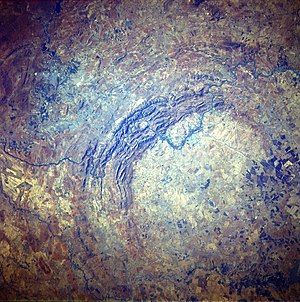Vredefort crater
| Vredefort Crater or dome | |
|---|---|
| Name as inscribed on the World Heritage List | |
 |
|
| Location | South Africa |
| Type | Natural |
| Criteria | viii |
| Reference | 1162 |
| UNESCO region | Africa |
| Inscription history | |
| Inscription | 2005 (29th Session) |
The Vredefort crater is the largest verified impact crater on Earth, more than 300 km across when it was formed. What remains of it is located in the present-day Free State Province of South Africa and named after the town of Vredefort, which is situated near its centre. Although the crater itself has long since eroded away, the remaining geological structures at its centre are known as the Vredefort Dome or Vredefort impact structure. In 2005, the Vredefort Dome was added to the list of UNESCO World Heritage Sites for its geologic interest.
The asteroid that hit Vredefort is estimated to have been one of the largest ever to strike Earth (at least since the Hadean Eon some four billion years ago), thought to have been approximately 10–15 km (6.2–9.3 mi) in diameter. The bolide that created the Sudbury Basin could have been even larger.
The original crater was estimated to have a diameter of roughly 300 km (190 mi), although this has been eroded away. It would have been larger than the 250 km (160 mi) Sudbury Basin and the 180 km (110 mi) Chicxulub Crater. The remaining structure, the "Vredefort Dome", consists of a partial ring of hills 70 km in diameter, and are the remains of a dome created by the rebound of rock below the impact site after the collision.
The crater's age is estimated to be 2.023 billion years (± 4 million years), which places it in the Paleoproterozoic Era. It is the second-oldest known crater on Earth, a little less than 300 million years younger than the Suavjärvi Crater in Russia. In comparison, it is about 10% older than the Sudbury Basin impact (at 1.849 billion years).
The dome in the center of the crater was originally thought to have been formed by a volcanic explosion, but in the mid-1990s, evidence revealed it was the site of a huge bolide impact, as telltale shatter cones were discovered in the bed of the nearby Vaal River.
...
Wikipedia
